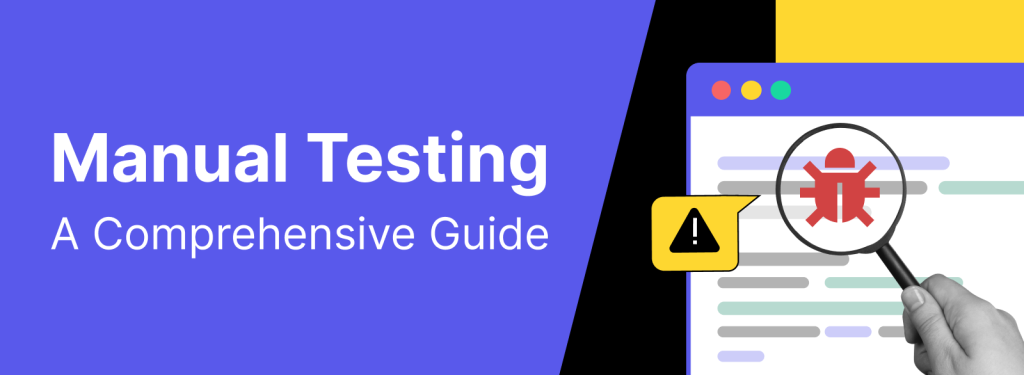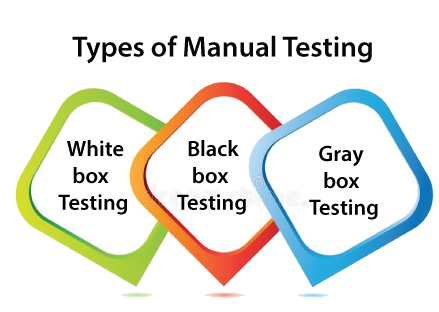
Hey all,
In this Tutorial, I will let you know the importance of manual testing in software development
Manual testing is the process of testing software without the use of automated tools. It is an essential part of the software development process, as it helps to ensure the quality of the software that is released to users.

There are many different manual testing techniques that can be used to test software. The best techniques to use will depend on the specific needs of the software project, but some of the most common techniques include:
- Black box testing: Black box testing is a type of testing where the tester does not have any knowledge of the internal structure of the software being tested. The tester only has access to the software’s external interfaces, such as its user interface and APIs.
Black box testing techniques are typically used to test the overall functionality of the software system. Some examples of black box testing techniques include:
* **Equivalence partitioning:** This technique divides the input domain of the software into equivalence classes, which are groups of inputs that are expected to produce the same output. The tester then selects a representative input from each equivalence class to test.
* **Boundary value analysis:** This technique focuses on testing the software at the boundaries of its input and output domains. For example, if the software expects a number between 1 and 100, the tester would test the software with the values 0, 1, 99, and 100.
* **Decision table testing:** This technique uses a decision table to identify all possible combinations of input conditions and the expected outputs for those combinations. The tester then executes test cases for each combination of input conditions.
* **State transition testing:** This technique uses a state transition diagram to model the behavior of the software. The tester then executes test cases to ensure that the software transitions from one state to another correctly.
- White box testing: White box testing is a type of testing where the tester has knowledge of the internal structure of the software being tested. The tester uses this knowledge to design test cases that target specific areas of the software’s code.
White box testing techniques are typically used to test specific areas of the software system, such as complex algorithms or security-critical components. Some examples of white box testing techniques include:
* **Unit testing:** Unit testing is the process of testing individual units of code, such as functions or classes. This is typically done by the developers themselves.
* **Integration testing:** Integration testing is the process of testing how different units of code interact with each other. This is typically done by testers.
* **System testing:** System testing is the process of testing the entire software system as a whole. This is typically done by testers.
- Grey box testing: Grey box testing is a type of testing that falls somewhere between black box testing and white box testing. The tester has some knowledge of the internal structure of the software being tested, but not as much as they would have in white box testing.
Grey box testing techniques are often used to test complex software systems or to test areas of the software that are difficult to test using black box testing techniques. Some examples of grey box testing techniques include:
* **API testing:** API testing is the process of testing the APIs of a software system. The tester uses their knowledge of the APIs to design test cases that verify the functionality and behavior of the APIs.
* **Database testing:** Database testing is the process of testing the database used by a software system. The tester uses their knowledge of the database schema to design test cases that verify the accuracy and integrity of the data in the database.
* **Security testing:** Security testing is the process of testing a software system for security vulnerabilities. The tester uses their knowledge of security principles and common security vulnerabilities to design test cases that identify potential security risks.Choosing the Right Manual Testing Techniques
The best manual testing techniques to use will depend on the specific needs of the software project. However, some general guidelines include:
- Use black box testing to test the overall functionality of the software system.
- Use white box testing to test specific areas of the software’s code, such as complex algorithms or security-critical components.
- Use grey box testing to test complex software systems or to test areas of the software that are difficult to test using black box testing techniques.
By using a combination of manual testing techniques, testers can help to ensure that software is thoroughly tested and that any defects are found and fixed before the software is released to you.
Detailing various manual testing techniques, such as black box testing, white box testing, and grey box testing
Black Box Testing

Black box testing is a type of software testing where the tester does not have any knowledge of the internal structure of the software being tested. The tester only has access to the software’s external interfaces, such as its user interface and APIs.
Black box testing techniques are typically used to test the overall functionality of the software system. Some examples of black box testing techniques include:
- Equivalence partitioning: This technique divides the input domain of the software into equivalence classes, which are groups of inputs that are expected to produce the same output. The tester then selects a representative input from each equivalence class to test.
- Boundary value analysis: This technique focuses on testing the software at the boundaries of its input and output domains. For example, if the software expects a number between 1 and 100, the tester would test the software with the values 0, 1, 99, and 100.
- Decision table testing: This technique uses a decision table to identify all possible combinations of input conditions and the expected outputs for those combinations. The tester then executes test cases for each combination of input conditions.
- State transition testing: This technique uses a state transition diagram to model the behavior of the software. The tester then executes test cases to ensure that the software transitions from one state to another correctly.
White Box Testing

White box testing is a type of software testing where the tester has knowledge of the internal structure of the software being tested. The tester uses this knowledge to design test cases that target specific areas of the software’s code.
White box testing techniques are typically used to test specific areas of the software system, such as complex algorithms or security-critical components. Some examples of white box testing techniques include:
- Unit testing: Unit testing is the process of testing individual units of code, such as functions or classes. This is typically done by the developers themselves.
- Integration testing: Integration testing is the process of testing how different units of code interact with each other. This is typically done by testers.
- System testing: System testing is the process of testing the entire software system as a whole. This is typically done by testers.
Grey Box Testing

Grey box testing is a type of software testing that falls somewhere between black box testing and white box testing. The tester has some knowledge of the internal structure of the software being tested, but not as much as they would have in white box testing.
Grey box testing techniques are often used to test complex software systems or to test areas of the software that are difficult to test using black box testing techniques. Some examples of grey box testing techniques include:
- API testing: API testing is the process of testing the APIs of a software system. The tester uses their knowledge of the APIs to design test cases that verify the functionality and behavior of the APIs.
- Database testing: Database testing is the process of testing the database used by a software system. The tester uses their knowledge of the database schema to design test cases that verify the accuracy and integrity of the data in the database.
- Security testing: Security testing is the process of testing a software system for security vulnerabilities. The tester uses their knowledge of security principles and common security vulnerabilities to design test cases that identify potential security risks.
Example of Manual Testing Techniques in Use
Here is an example of how manual testing techniques can be used in practice:
A software tester is tasked with testing a new e-commerce website. The tester begins by using black box testing techniques to test the overall functionality of the website. This includes testing the following:
- The user interface is easy to use and navigate.
- The product catalog is accurate and up-to-date.
- The shopping cart and checkout process work correctly.
- Orders are processed and shipped correctly.
The tester then uses white box testing techniques to test specific areas of the website’s code, such as the following:
- The algorithm used to calculate shipping costs is correct.
- The database is able to handle a large number of concurrent users.
- The website is secure from common security vulnerabilities.
Finally, the tester uses grey box testing techniques to test more complex areas of the website, such as the following:
- The integration between the website and the company’s order fulfillment system.
- The performance of the website under heavy load.
- The user experience of the website on different devices and browsers.
By using a combination of black box, white box, and grey box testing techniques, the tester is able to thoroughly test the e-commerce website and identify any defects before the website is launched.
Conclusion
Manual testing techniques are an essential part of the software testing process. By using a combination of different manual testing techniques, testers can help to ensure that software






Leave a Reply
You must be logged in to post a comment.